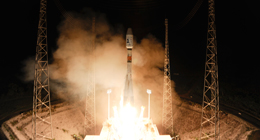Watch the replay highlights of today’s webcast of ESA’s billion-star surveyor Gaia launching into space. Lift off took place at 09:12 GMT / 10:12 CET this morning.
This video includes highlights of the launch webcast including lift-off from Kourou, the Soyuz mission, separation of Gaia and the successful entry into orbit.
Like to see the entire webcast replay? Access the full video in the ESA website.


Discussion: 5 comments
Congratulations!
Gaia uses parallax to measure distances, right?
Why is it put at a lagrange point instead of in a trajectory outwards, giving it ever better parallax over time? In 6 years mission time it could reach Jupiter, at 5 times the radius from the Sun.
A great video with very informative commentary, celebrating a wonderful achievement for the whole team. Congratulations on a successful launch and best wishes for the programme.
To Begaiastert : the team will precise the answer if needed (but they must be busy at the moment 😉 ! I asked myself the question, and found several good reasons not to do it. So, a tentative answer :
– Power ! Far from the sun, not enough power => it needs nuclear power, not so easy and very expensive, and thermal problems …
– Communication … : far from earth, no way to send the info at several Mbit/s ;-(
– thermal stability : while going far, the temperature of the shield will decrease, creating perturbations and unwanted vibrations. At constant distance, much less problems 😉
– Not so useful ;-). Gaia rotates around the Sun, but the Sun itself travels through the Galaxy (at about 200km/s) : so, we already benefit from this move through the Galaxy to change the point of view. Hence, no need to go far from the Sun (at “only” a few tens of km/s) !
And congratulations for this successful launch !
Oh, the speed of the Sun relative to those billion stars?
History books talk about the parallax as the Earth orbiting the Sun relative to the few nearest stars. But here are greater things going on. I think my spinning head can almost imagine it now, thanx!
Wonderful to watch the replay of the lift-off. I was amazed at Jerome Lalande’s achievement of mapping 47,000 or so stars with a telescope in 1801, but Gaia’s mission of aiming to log over a billion stars is just awesome. I get the same feeling about Gaia as I do for Hubble – a truly wonderful undertaking. Well done everyone!